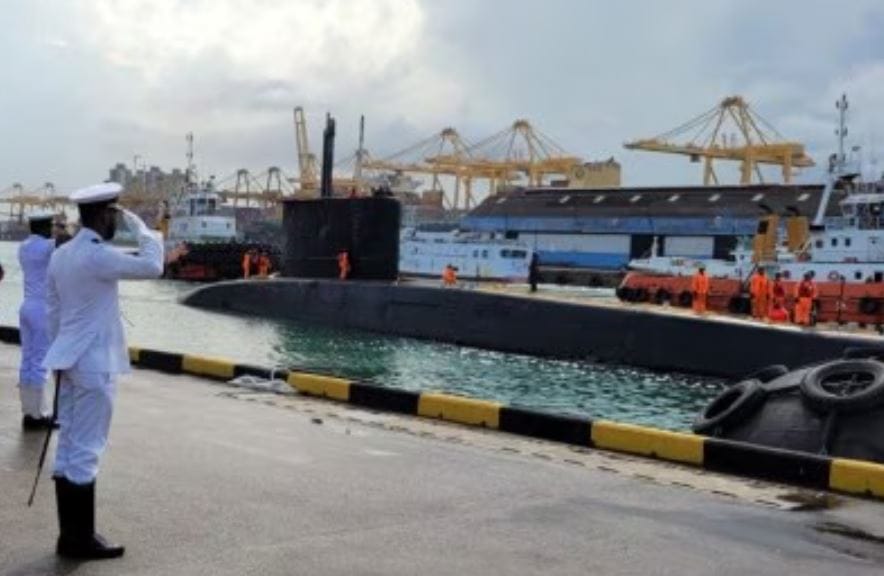Indian Submarine INS Shalki: A Strategic Visit Amid Rising Tensions
INS Shalki’s Diplomatic Mission to Sri Lanka
The recent arrival of the Indian submarine INS Shalki in Colombo underscores a significant moment in maritime diplomacy. The visit, which commenced on August 2, 2024, reflects the strengthening maritime security cooperation between India and Sri Lanka. This two-day diplomatic engagement highlights India’s strategic interests in countering China’s growing influence in the region.
INS Shalki, part of the Shishumar class, represents a notable asset in India’s naval fleet. Commissioned into the Indian Navy on February 7, 1992, it was the first submarine built indigenously in India, marking a milestone in the nation’s defense capabilities. The submarine’s presence in Colombo signals India’s commitment to enhancing bilateral defense ties and showcasing its strategic capabilities.
A Ceremonial Welcome Amidst Geopolitical Dynamics
Upon its arrival in Colombo, INS Shalki received a ceremonial welcome from the Sri Lankan Navy, reflecting the cordiality and strategic nature of the visit. This gesture underscores the mutual respect and growing defense collaboration between the two nations. The visit is part of India’s broader strategy to fortify its defense relationships with countries in the Indian Ocean region, especially in the face of China’s persistent efforts to expand its military and strategic footprint.
This visit follows earlier engagements, such as the arrivals of Kalvari class submarines INS Karanj and INS Vagir in Colombo in February and June of the previous year. These visits are indicative of India’s strategic outreach and its intent to maintain a robust naval presence in the region.
India’s Strategic Interests and Regional Tensions
The timing of INS Shalki’s visit is particularly significant given the backdrop of China’s ongoing attempts to bolster its strategic influence over Sri Lanka. The docking of the Chinese missile and satellite tracking ship ‘Yuan Wang’ at Hambantota port in August 2022 had already stirred diplomatic tensions between India and Sri Lanka. Moreover, another Chinese warship’s visit to Colombo port in August of the previous year has heightened India’s strategic concerns.
In response to these developments, India has been actively involved in supporting Sri Lanka’s defense capacity. This includes the provision of indigenously constructed Offshore Patrol Vessels, enhancing the Sri Lankan Navy’s capabilities and reinforcing strategic ties. The INS Shalki’s visit further symbolizes India’s proactive stance in safeguarding its regional interests and ensuring a balance of power in the Indian Ocean.
Summary
The visit of the INS Shalki to Sri Lanka epitomizes the strengthening maritime collaboration between India and Sri Lanka amid growing regional tensions. This engagement highlights India’s strategic efforts to counterbalance China’s expanding influence and underscores its commitment to enhancing bilateral defense relations.
Key Learning Points
| Point | Detail |
|---|---|
| INS Shalki’s Arrival | Indian submarine’s visit to Colombo symbolizes enhanced maritime security cooperation. |
| Ceremonial Welcome | The Sri Lankan Navy’s reception reflects mutual respect and strategic partnership. |
| Geopolitical Context | The visit is set against China’s growing military presence and strategic influence in the region. |
| Previous Engagements | Earlier visits by INS Karanj and INS Vagir highlight ongoing strategic outreach. |
| India’s Strategic Measures | India supports Sri Lanka’s defense capabilities to balance regional power dynamics. |
Soumya Smruti Sahoo is a seasoned journalist with extensive experience in both international and Indian news writing. With a sharp analytical mind and a dedication to uncovering the truth, Soumya has built a reputation for delivering in-depth, well-researched articles that provide readers with a clear understanding of complex global and domestic issues. Her work reflects a deep commitment to journalistic integrity, making her a trusted source for accurate and insightful news coverage.



